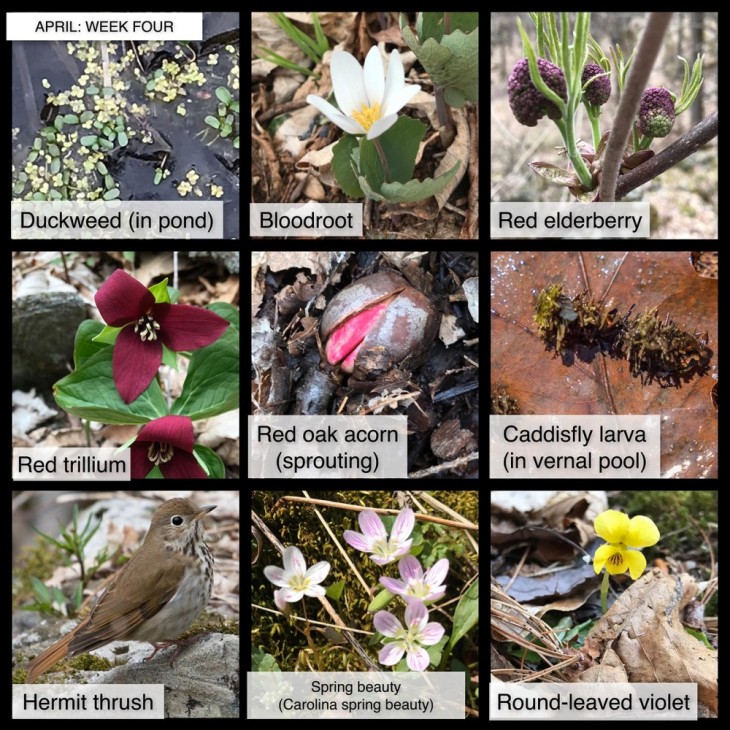The spring ephemeral wildflower show continues. Red trillium (wakerobin) and round-leaved violets are just coming into bloom, while bloodroot is continuing (notice how it folds up its leaves and flowers on overcast days?). We’re also finding Dutchman’s breeches scattered here and there. To learn more about how these plants spread their seeds, see this article by Howard Krum.
Also appearing in abundance right now: Carolina spring beauty – distinguishable from Virginia spring beauty for its wider leaves, versus its cousin’s grass-like blades. This exquisite little wildflower with striped petals comes in a variety of shades from white to deep pink.
Red maple blossoms may be starting to fade, but if you’re lucky, you’ll stumble upon the striking purple buds of red elderberry (not to be confused with common elderberry, which flowers later). Here’s information from Mary Holland’s blog, describing the high wildlife value of this shrub.
Another source of color on the forest floor: acorns. Where we are, in the Connecticut River’s Upper Valley, white oaks are uncommon, and the acorns we find in the woods are almost always from red oaks. Those lucky acorns that have escaped the attention of rodents (or been moved and forgotten by them – see this essay by Susie Spikol) are busting out of their shells and preparing to make little trees. Notice the emerging radicle (embryonic root), and the festive pink color of the cotyledons (the nut meat).
Our migratory birds are returning and filling the woods with song. One woods bird that we’ve seen on several occasions this week, is the hermit thrush. Part of the “little brown bird club” and the “confusing thrush club” it can be hard to identify on the wing. The photographed bird obligingly posed for us in a way that displayed its distinctive red tail. Here’s an essay about hermit thrushes by Susan Shea, with due deference given to their beautiful song.
Still water bodies are becoming opaque, as pollen accumulates on the surface. On ponds and lakes, common duckweed also obscures the view. See this article by Declan McCabe, describing a fun experiment to measure starch in the leaves.
Even if you can’t see into vernal ponds through pollen haze, if you scoop up muck from the edge (being careful not to disturb amphibian eggs, of course!) you’re likely to find caddisfly larvae. These fascinating insects encase themselves in tiny twigs and other detritus, which they carry around as they travel the pool. Caddisflies aren’t just in vernal pools, however; different species have adapted to live in a variety of aquatic habitats. See this essay describing stream and river species. And here’s a nice summary of common vernal pool species, with two illustrations of vernal pool caddisflies, posted by Mass Audubon.
In this difficult period, many of us find joy in observing local nature, and many families are seeking outdoor enrichment opportunities for children. Here are nine photographs taken this past week in forests within 15 miles of the Northern Woodlands office in Lyme, New Hampshire. We hope you enjoy using this grid as a prompt for your own explorations, or as the basis for a game of family forest tic-tac-toe.
What are you seeing in the woods this week? Share your images with us on Facebook, or submit a special photo for possible inclusion in our monthly online Reader Photo Gallery.


